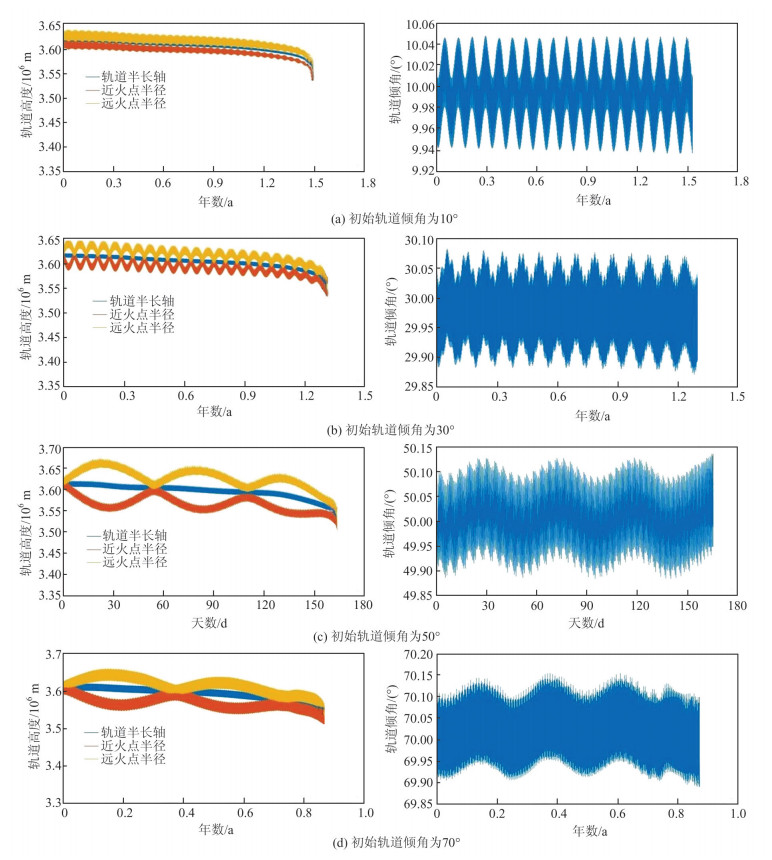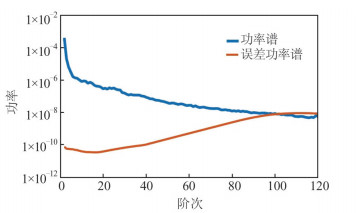-
摘要: 针对火星探测器在轨运行时长的问题,使用武汉大学自主研制的火星探测器精密定轨与重力场解算软件系统MAGREAS(Mars gravity recovery and analysis software/system),分别对火星探测器在不同初始轨道高度、不同初始轨道倾角、不同初始轨道偏心率以及不同阶次火星重力场等影响因素下,进行轨道演化的分析。结果表明,小偏心率且轨道高度在250 km及以上的探测器可以长时间运行,在不进行任何调整的情况下运行时间接近两年;初始轨道倾角为90°时,不利于探测器的运行时长;在轨道积分的运算中,火星重力场模型MRO120D可以截取到100阶而不影响计算精度。该成果可以为中国的火星探测工程提供一定参考。Abstract:Objectives The Chinese Mars probe has been successfully launched and is currently orbiting Mars. This article analyzes several different satellite orbit characteristics in detail to find out the suitable orbits with stable operation characteristics.Methods This paper uses the MAGREAS(Mars gravity recovery and analysis software/system)independently developed by Wuhan University to analyze the evolution of satellite orbits under different initial orbit heights, different initial orbital inclinations, different initial orbital eccentricities, and different orders of Martian gravitational field models. Then we make orbit predictions for the four situations.Results The results show that satellite can run for nearly two years without any orbital adjustment. When the initial orbital inclination is 90°, it does not contribute to the running time of the satellite. In the calculation of orbital integration, the Martian gravity field model can be intercepted to 100 degrees without affecting the calculation accuracy.Conclusions This paper has done a lot of orbit predictions based on different initial orbit elements, and analyzed the evolution characteristics of different satellite orbits. This research can provide a certain reference for China's Mars exploration project.
-
Keywords:
- Mars gravity field model /
- MRO120D /
- Mars probe /
- orbital evolution
-
随着中国经济的飞速发展,工业、交通也迅猛发展,城市扩张,人口集中,各种环境问题也层出不穷,其中大气污染,尤其是颗粒物(气溶胶)污染具有广泛的空间分布,对人体健康产生较大危害[1]。空气动力学当量直径小于10 μm的颗粒物被称为PM10,直径小于2.5 μm的颗粒物被称为PM2.5,二者均具有可吸入性,前者通常可以沉积到上呼吸道,而后者可以进入肺泡,对身体危害极大;同时细颗粒物在大气中停留时间长,也影响了大气能见度和大气环境质量[1-3]。
在颗粒物污染监测中,近地表的监测备受人们关注,各个城市中普遍设立了空气质量监测站,同时监测颗粒物浓度(PM10、PM2.5)、硫氧化物、氮氧化物等参数,能够测量站点附近大气污染的详细参数,测量精度高,但受制于成本,不能广泛布站,覆盖区域的测量很难实现,无法全面反映气溶胶的分布。激光雷达作为一种遥感手段,能够进行长距离、高频次的探测,探测结果可以有效反映激光传输路径内的气溶胶分布情况,是当前遥感探测颗粒物污染的有效手段,被广泛应用于城市大气污染探测中[4-11]。国内外多家单位开展了激光雷达用于大气探测的研究,其中中科院安光所[4-7]、武汉大学[8]、西安理工大学[9]等多家国内单位,以及法国索邦大学[10]、日本国立环境研究所[11-12]、意大利[13]、美国NOAA[14]等国外研究机构均利用激光雷达进行了颗粒物探测。
当前国内外的研究中,都是单独进行垂直探测[1, 5, 8-10, 12-17]或者水平探测[4, 6-7],鲜有结合三维探测的激光雷达数据进行相关研究。垂直探测可以确定探测地点上空的气团垂直分布和运动,但是不能获得区域性的颗粒物分布;水平探测可用于识别该区域的颗粒物水平分布,但牺牲了时间分辨率,无法获得颗粒物的传输规律;而同时结合垂直和水平探测组成的三维数据,即可实现两种探测方式的优势互补,从而实现对颗粒物更全面的监测和研究。本文即利用两台微脉冲激光雷达对天津市武清区中心城区进行了全天时的遥感探测,其中一台激光雷达进行垂直测量,探测颗粒物的传输、沉降;另外一台激光雷达架设于高楼顶,进行水平扫描,探测颗粒物的水平分布。通过对两台激光雷达的三维数据的分析,揭示区域性的颗粒物污染分布和传输情况。
1 三维大气污染探测原理与方法
1.1 大气探测激光雷达原理
激光雷达是一种主动探测设备,它向大气中发射激光脉冲,激光束与大气气溶胶粒子和大气分子等发生相互作用,产生回波信号被接收望远镜接收,然后对回波信号进行采集、反演就可以得到大气气溶胶的光学特征信息。激光雷达探测大气颗粒物具有很高的空间和时间分辨率,是目前有效获得大气颗粒物垂直分布廓线的重要手段。
1.2 实验方法和研究区域介绍
本文研究中为了获取大气颗粒物的三维数据,同时采用了两台激光雷达分别进行大气垂直和水平扫描探测。垂直探测和水平扫描激光雷达的技术指标如表 1所示。在大气激光雷达探测中一般采用的是Nd:YAG激光器的基频光,即1 064 nm,因此本文采用的激光雷达的激光波长均为1 064 nm。同时对激光雷达进行了一体化设计,并加入窄带滤光片,使得其具有全天时、全天候工作能力,从而实现24 h连续监测。
表 1 激光雷达技术参数Table 1. Parameters of the Two LiDARs参数 垂直LiDAR 水平LiDAR 波长/nm 1 064 1 064 能量/μJ >100 >20 脉冲频率/kHz 1 1 望远镜口径/ mm 100 100 距离分辨率/m 30 15 滤光片带宽/nm 0.5 0.5 激光雷达的布设区域选择在天津市武清区城区。武清城区处于京津冀的中心地带,其大气颗粒物污染受外地源影响较为明显,希望通过激光雷达遥感探测的手段找出污染的传输方向,并初步判定污染源。垂直探测激光雷达和水平探测激光雷达分别部署于同一小区中不同建筑楼顶,为保证水平探测路径内无遮挡,将水平探测激光雷达部署于城区内的一栋33层居民楼楼顶,具体地理位置在水平扫描结果中可见。
1.3 垂直探测激光雷达反演算法
大气探测激光雷达信号反演中一般采用Fernald算法[18],该算法主要是区分了大气气溶胶和大气分子,并引入激光雷达比的概念,进行大气气溶胶消光系数和后向散射系数的计算。具体如下:
$$ {P(r) = EC{r^{ - 2}}\beta (r)\exp \left[ { - 2\int_0^r \sigma (r){\rm{d}}r} \right]} $$ (1) $$ {{S_1} = {\sigma _1}(r)/{\beta _1}(r)} $$ (2) $$ {{S_2} = {\sigma _2}(r)/{\beta _2}(r)} $$ (3) $$ \begin{array}{l} {\sigma _1}(I - 1) + \frac{{{S_1}}}{{{S_2}}}{\sigma _2}(I - 1) = X(I - 1) \times \\ \exp [ + A(I - 1, I)]/\left\{ {\frac{{X(I)}}{{{\sigma _1}(I) + \left( {{S_1}/{S_2}} \right){\sigma _2}(I)}} + } \right.\\ X(I)\Delta r + X(I - 1)\exp [ + A(I - 1, I)]\Delta r\} \end{array} $$ (4) 式(1)为典型的大气激光雷达方程,是大气颗粒物探测的基本方程,所有利用激光雷达进行大气探测均是基于该方程进行的,其中,P为激光雷达回波信号强度功率;r代表探测距离;E为激光雷达固定参数,包括发射激光功率等;C为矫正常数;β为大气后向散射系数;σ为大气消光系数。式(2)和式(3)分别是大气气溶胶和大气分子的激光雷达比计算方程,是Fernald算法的核心,其中S1和S2分别是大气气溶胶和大气分子的激光雷达比;大气分子的激光雷达比为固定值8π/3,下标1表示大气颗粒物/气溶胶,下标2表示大气分子。式(4)为利用Fernald算法进行消光系数的后向积分方程,其中I代表高度相关的计数值。
通过确定激光雷达比、标定高度和标定高度处的大气气溶胶消光系数3个参数后,即可以利用Fernald算法进行气溶胶消光系数的计算。其中激光雷达比一般采用定值简化计算,本文设定为50;标定高度选择在相对洁净、大气气溶胶少的区域,本文选择高度10 km为标定高度rc,该处的气溶胶消光系数计算采用经验公式a1(rc)=(1.01-1)a2(rc)计算[18],其中分子的消光系数由大气模式给出。
1.4 水平扫描激光雷达反演算法
水平扫描激光雷达信号处理算法是在垂直探测算法的基础上完成的。目前一般采用的是斜率法或者Fernald法,但前者的问题在于其假定的大气分布均匀状态在实际情况下不成立,而后者的弊端在于无法获得标定高度(距离)及在此处的气溶胶消光系数[18-21]。
为减小反演误差,本文结合斜率法和Fernald算法,提出了一种新的水平扫描反演算法。斜率法不存在激光雷达比的问题,但水平方向上某小段距离内可以认为大气状态均匀,在本次实验中,先根据原始激光雷达信号确定大气分布均匀的一段距离,并以斜率法获取该处的气溶胶平均消光系数,将结果作为Fernald算法的标定高度(距离)和此处的消光系数标定值。
由于获取的是中间距离的消光系数,因此利用Fernald算法时,分别进行前向和后向积分,从而得到较为准确的大气气溶胶消光系数反演结果。
2 三维大气污染探测实验与结果分析
本文选取2018年7月16日水平和垂直激光雷达数据进行反演,揭示该地区的颗粒物三维分布特征,并同地面空气质量国控站点的PM数据进行校正和对比分析。
2.1 垂直探测结果分析
对7月16日连续24 h的垂直探测结果,利用Fernald算法进行反演,标定高度选为10 km,图 1(a)为2018年7月16日凌晨00:30时刻的单条垂直激光雷达距离校正信号,可以看出激光传输距离较远,表明高层大气较为洁净,在高度0.5 km附近,信号强度先增加后减小是由于overlap效应造成的,即激光没有完全进入望远镜视场;在高度2.5 km处,激光雷达回波信号出现突增现象,表明此处有明显的云层,但厚度较薄,穿过云层后激光的衰减较小,继续传输至高空中。
图 1(b)是7月16日连续24 h垂直探测得到的大气气溶胶消光系数,通过消光系数可以直接反映出大气气溶胶的浓度情况,其中高度2.5 km处的消光系数出现极大值,是由于云层造成的,不在本文的研究范围内。
一般情况下,气溶胶主要集中在边界层内,由于探测时间为夏天,边界层高度较高,利于污染物扩散。根据查询到的气象数据,激光雷达探测从0时至早上8时左右,边界层以下的颗粒物浓度较低,且呈逐渐消散(扩散)的趋势;但从早上8时左右开始,上午低空的气溶胶消光系数持续增加,可以看出,颗粒物污染也持续增加,表明当地的人为颗粒物排放较为严重,同时颗粒物由低空向高空传输的特征明显,因此可以判定当天的大气气溶胶污染主要是本地源,即从地面向高空扩散;白天污染持续增加,到夜晚24时达到顶峰,这一现象主要是人为活动造成的。武清区是天津和北京的交界处,该处白天和夜晚的交通活动较强,同时夜晚气溶胶浓度持续增加的主要原因不排除当地企业夜间生产偷排的情况。
2.2 水平扫描结果分析
通过布设在居民楼顶的水平扫描激光雷达(117.04°E,39.39°N)探测气溶胶在水平方向上的分布。为了保证信噪比,将单次扫描角度时间设置为20 s,扫描步进角度为2°,水平方向顺时针扫描一圈时间为1 h。利用本文提出的水平反演算法进行了消光系数反演,图 2(a)为7月16日凌晨00:30激光雷达单次扫描得到的距离校正信号,同图 1(a)相比,水平探测中,由于地表附近较高空气溶胶浓度高,因此回波信号随距离增加而衰减的程度较大;同时由于水平气溶胶分布的不均匀性,水平探测的回波信号波动也较大,采用斜率法进行反演会造成一定的反演误差。
图 2(b)为水平方向上1 h(16日凌晨00:25-01:25)探测得到的大气气溶胶消光系数分布图,其中A为激光雷达站点位置,图中消光系数较大的区域气溶胶浓度较高,此段时间内污染集中在以探测点为中心的主城区内,以及南部高铁站附近。由于是凌晨,气溶胶污染主要集中在城区附近,人口密度高,与生产、生活、交通的污染排放有关,而郊区的人类活动和生产较少,污染较低。
图 2(c)为一天24 h连续探测后的数据融合结果,反映24 h内区域中的污染较大区域分布。采取的方法是提取高污染区域的颗粒物数据,剔除低污染部分,并融合到一张图中。可以看出,当天24 h内共有8个污染较重的区域,标号3~8的污染区域主要集中在城区中,表明城区人为活动是造成颗粒物污染的主要原因;1号、2号区域位于远城区,人类活动较少,但实际污染程度也较大,根据实地调查,两处地区有本地工厂,工业活动是造成该区域气溶胶浓度上升的主要原因。
根据垂直激光雷达探测的结果,如图 1(a)所示,可知当天气溶胶污染源主要是本地源,结合图 2(c),充分表明在本地污染源起主导作用的情况下,大气气溶胶污染主要集中在城区部分;同时结合图 2(b)可知,城区地区发达的交通和密集的人口加重了武清区的夜间污染,且密集的建筑物使得气溶胶扩散不易。
3 讨论
需要说明的是,激光雷达探测反演得到的颗粒物消光系数是相对值,可以在一定程度上反映出观测区域中的颗粒物浓度情况,一般情况下,这种探测结果结合地面国控站数据即可实现区域内的颗粒物密集监测,但无法直接将颗粒物的消光系数转换到绝对的颗粒物浓度值。研究表明,颗粒物浓度同激光雷达探测得到的消光系数间存在一定的线性关系,尤其是颗粒物消光系数和PM10之间的线性关系更为明显。因此在完成垂直和水平激光雷达探测实验后,为初步验证激光雷达探测结果的准确性,将激光雷达水平扫描结果同地面站点数据进行对比,地面站点数据采用的是扫描区域内的国控站点PM10数据。
需要指出的是,由于激光雷达是位于高点处进行扫描的,其探测结果同地面国控站点间必定存在一定的偏差,因此在进行相关性计算时,需要考虑到当天的风速和风向,若风速较大,需要以下风处的气溶胶消光系数平均值作为对比值,为了降低对比误差,本文此次选取了风速较低的情况下的数据。
图 3是激光雷达探测到的气溶胶消光系数同PM10间的相关性对比,由于水平激光雷达数据获取周期为1 h,因此对国控站的PM10数据进行小时平均,采用223组对比数据,即近10 d的数据,拟合得到的颗粒物消光系数反演PM10浓度的经验公式为:y=767.82x+10.08,R2为0.85,表明二者间的线性关系较为明显,即颗粒物的消光系数可以转换为精度较高的颗粒物浓度数据。若通过长期数据积累,可以得到更为准确的经验公式。
通过上述实际数据对比分析,可以认为气溶胶消光系数和颗粒物浓度(尤其是PM10)间的线性程度较高,因此,在获取一定时间内的经验公式后,可以利用激光雷达探测到的气溶胶消光系数的水平分布图,直接反映扫描区域内颗粒物浓度的分布情况。
4 结语
本文利用两台激光雷达分别进行垂直方向和水平扫描探测,获得了区域性的气溶胶三维分布结果。其中利用垂直探测得到气溶胶的垂直分布,并说明一天24 h内边界层高度变化下低层大气气溶胶的扩散情况,初步揭示当天的气溶胶污染源是本地或是外地;同时利用布设在高楼顶的水平扫描激光雷达获取气溶胶的水平分布结果,探明扫描区域内的气溶胶污染分布情况。三维数据的激光雷达相比于传统的被动站点布设,能以更少的成本反映区域的气溶胶分布情况以及变化趋势,为城市颗粒物监测和治理提供了有效的测量手段。
需要指出的是,单独的激光雷达只能对区域气溶胶进行实时监测,若加上偏振通道,则可以区分本地和外源沙尘性气溶胶,但仍然无法实现对污染物的溯源、预测。而卫星遥感手段能够对大尺度的PM2.5、PM10进行监测,结合气象数据,构建后向轨迹模型,追溯气团运动轨迹,可以实现对颗粒物污染的追踪和预测,这也是下一步需要完善的工作。
-
表 1 不同初始轨道高度下飞行器轨道根数的变化
Table 1 Orbital Elements Variation Under Different Initial Orbit Heights
轨道高度/km Δa/m Δe Δi/(°) t/d 150 -97 156.972 0.013 9 0.006 4 1.21 220 -175 463.755 0.010 6 0.072 6 98.85 250 -20 092.282 0.019 3 0.101 5 664.12 300 49 715.827 0.013 1 -0.211 0 729.00 表 2 不同轨道倾角下轨道根数的变化(220 km高度)
Table 2 Variation of the Orbital Elements Under Different Orbit Inclinations (at the Height of 220 km)
轨道倾角i/(°) Δa/m Δe Δi/(°) t/d 10 -170 268.585 0.013 6 -0.037 6 559.10 30 -169 592.142 0.013 7 -0.058 5 477.36 50 -169 054.000 0.013 4 0.001 1 134.71 70 -202 067.199 0.018 6 -0.109 3 321.95 90 -175 463.755 0.010 6 0.072 6 98.85 表 3 重力场不同阶数下轨道长半轴和轨道偏心率的变化对比
Table 3 Comparison of Changes in Orbital Semi-major Axis and Orbital Eccentricity Under Different Orders of Gravity Field
阶数比较 maxΔa/m maxΔe 120阶和100阶 15 0.000 003 120阶和80阶 35 0.000 009 120阶和50阶 40 0.000 010 -
[1] 侯建文. 深空探测: 火星探测[M]. 北京: 国防工业出版社, 2016 Hou Jianwen. Deepspace Exploration-Mars Exploration[M]. Beijing: National Defense Industry Press, 2016
[2] Wu J, Zhu G W, Zhao H, et al. Scientific Objectives of China-Russia Joint Mars Exploration Program YH-1[J]. Chinese Astronomy and Astrophysics, 2009, 34(2): 163-173 http://www.sciencedirect.com/science/article/pii/S027510621000024X
[3] Chen C Y, Fang B D, Cao Z Y, et al. The Design Features and Research Processing of YH-1 Mars Probe[J]. Aerospace Shanghai, 2009, 5(3): 21-25 http://en.cnki.com.cn/Article_en/CJFDTOTAL-SHHT200903004.htm
[4] 吴季, 朱光武, 赵华, 等. 萤火一号火星探测计划的科学目标[J]. 空间科学学报, 2009, 29(5): 449-455 https://www.cnki.com.cn/Article/CJFDTOTAL-KJKB200905003.htm Wu Ji, Zhu Guangwu, Zhao Hua, et al. Overview of Scientific Objectives of China-Russia Joint Mars Exploration Program YH-1[J]. Chinese Journal of Space Science, 2009, 29(5): 449-455 https://www.cnki.com.cn/Article/CJFDTOTAL-KJKB200905003.htm
[5] 郑伟, 徐厚泽, 钟敏, 等. "萤火一号"火星探测计划进展和Mars-SST火星卫星重力测量计划研究[J]. 测绘科学, 2012, 37(2): 44-48 https://www.cnki.com.cn/Article/CJFDTOTAL-CHKD201202016.htm Zheng Wei, Xu Houze, Zhong Min, et al. Progress in "Yinghuo-1" Martian Exploration Program and Research on Mars-SST Satellite Gravity Measurement Mission[J]. Science of Surveying and Mapping, 2012, 37(2): 44-48 https://www.cnki.com.cn/Article/CJFDTOTAL-CHKD201202016.htm
[6] Yan Jianguo, Yang Xuan, Ye Mao, et al. New Tracking Modes and Performance for Mars Spacecraft Orbit Determination and Lander Positioning[J]. Planetary and Space Science, 2018: S0032063317301514
[7] Yan J, Yang X, Ye M, et al. Independent Mars Spacecraft Precise Orbit Determination Software Development and Its Applications[J]. Astrophysics and Space Science, 2017, 362(7): 123-130 doi: 10.1007/s10509-017-3105-0
[8] 杨轩, 鄢建国, 叶茂, 等. 火星探测器精密定轨软件研制及实测数据处理[J]. 武汉大学学报·信息科学版, 2019, 44(3): 385-391 doi: 10.13203/j.whugis20160494 Yang Xuan, Yan Jianguo, Ye Mao, et al. Development of Precise Orbit Determination Software for Mars Probe and Data Processing for MEX[J]. Geomatics and Information Science of Wuhan University, 2019, 44(3): 385-391 doi: 10.13203/j.whugis20160494
[9] 曹建峰, 刘磊, 黄勇, 等. 火星指向模型与重力场模型的发展回顾与使用[J]. 天文学进展, 2007, 35(1): 127-139 https://www.cnki.com.cn/Article/CJFDTOTAL-TWJZ201701008.htm Cao Jianfeng, Liu Lei, Huang Yong, et al. Review and the Utilization of Martian Orientataion Model and Gravity Field Model[J]. Progress in Astronomy, 2007, 35(1): 127-139 https://www.cnki.com.cn/Article/CJFDTOTAL-TWJZ201701008.htm
[10] Yan J, Yang X, Hao W, et al. A New Tracking Mode for Improved Martian Gravity Field Measurement[J]. Astrophysics and Space Science, 2017, 362(12): 236-242 doi: 10.1007/s10509-017-3214-9
[11] 叶茂, 李斐, 鄢建国, 等. GRAIL月球重力场模型定轨性能分析[J]. 武汉大学学报·信息科学版, 2016, 41(1): 93-99 doi: 10.13203/j.whugis20150008 Ye Mao, Li Fei, Yan Jianguo, et al. Orbit Determination Ability Analysis of the GRAIL Gravity Model[J]. Geomatics and Information Science of Wuhan University, 2016, 41(1): 93-99 doi: 10.13203/j.whugis20150008
[12] Smith D E, Sjogren W L, Tyler G L, et al. The Gravity Field of Mars: Results from Mars Global Surveyor[J]. Science, 1999, 286(5 437): 94-97 doi: 10.1126/science.286.5437.94
[13] Reasenberg R D, Shapiro I I, White R D. The Gravity Field of Mars[J]. Geophysical Research Letters, 2013, 2(3): 89-92
[14] 鄢建国, 平劲松. 火星重力场研究现状及发展趋势[J]. 物理, 2009, 38(10): 707-711 https://www.cnki.com.cn/Article/CJFDTOTAL-WLZZ200910005.htm Yan Jianguo, Ping Jinsong. A Gravity Field Model for Mars[J]. Physics, 2009, 38(10): 707-711 https://www.cnki.com.cn/Article/CJFDTOTAL-WLZZ200910005.htm
[15] Lewis S R, Collins M, Read P L, et al. A Climate Database for Mars[J]. Journal of Geophysical Research Planets, 1999, 104(E10): 24 177–24 194 doi: 10.1029/1999JE001024
[16] Forget F, Hourdin F, Fournier R, et al. Improved General Circulation Models of the Martian Atmosphere from the Surface to Above 80 km[J]. Journal of Geophysical Research Planets, 1999, 104(E10): 24 155-24 176 doi: 10.1029/1999JE001025
[17] Folkner W M, James G W, Dale H B. The Planetary and Lunar Ephemeris DE 421[J]. Interplanetary Network Progress Report, 2009, 42(178): 1-34 http://adsabs.harvard.edu/abs/2009ipnpr.178c...1f
[18] Jakosky B M, Lin R P, Grebowsky J M, et al. The Mars Atmosphere and Volatile Evolution(MAVEN) Mission[J]. Space Science Reviews, 2015, 195(1): 1-4 doi: 10.1007/s11214-015-0221-4
[19] 刘林, 汤靖师. 卫星轨道偏心率的变化特征及其对轨道寿命的影响[J]. 天文学进展, 2009, 27(1): 58 -69 doi: 10.3969/j.issn.1000-8349.2009.01.005 Liu Lin, Tang Jingshi. The Variable Feature of Orbital Eccentricity and Its Influence on Orbital Lifetime[J]. Progress in Astronomy, 2009, 27(1): 58-69 doi: 10.3969/j.issn.1000-8349.2009.01.005
[20] Lemoine F G, Goossens S, Sabaka T J, et al. GRGM900C: A Degree 900 Lunar Gravity Model from GRAIL Primary and Extended Mission Data[J]. Geophysical Research Letters, 2014, 41(10): 3 382-3 389 doi: 10.1002/2014GL060027
[21] Mazarico E, Genova A, Goossens S, et al. The Gravity Field, Orientation, and Ephemeris of Mercury from MESSENGER Observations After Three Years in Orbit[J]. Journal of Geophysical Research Planets, 2015, 119(12): 2 417-2 436 doi: 10.1002/2014JE004675
[22] Konopliv A S, Park R S, Yuan D N, et al. High‐Resolution Lunar Gravity Fields from the GRAIL Primary and Extended Missions[J]. Geophysical Research Letters, 2014, 41(5): 1 452–1 458 doi: 10.1002/2013GL059066
[23] Konopliv A S, Banerdt W B, Sjogren W L. Venus Gravity: 180th Degree and Order Model[J]. Icarus, 1999, 139(1): 3-18 doi: 10.1006/icar.1999.6086
-
期刊类型引用(3)
1. 陶叶青,束明聪,陈浩. 基于分类估计的异质数据融合M_(split)模型. 淮阴师范学院学报(自然科学版). 2025(01): 45-51 .  百度学术
百度学术
2. 张双成,赵颖,张成龙,张菊清,樊茜佑,司锦钊,张雅斐,朱武,李振洪. 联合光学遥感和SAR影像青海玛多Ms 7.4地震同震形变场分析. 武汉大学学报(信息科学版). 2025(03): 469-482 .  百度学术
百度学术
3. 丁明涛,陈浩杰,李振洪,刘振江. 利用光学遥感影像光流场模型进行地表形变分析. 武汉大学学报(信息科学版). 2024(08): 1314-1329 .  百度学术
百度学术
其他类型引用(2)





 下载:
下载:











